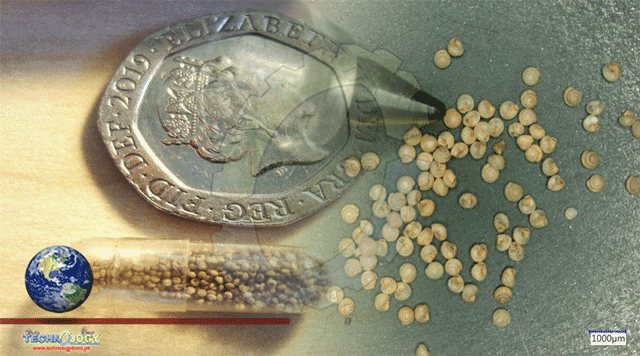Scientists have discovered two new snail species the size of a grain of sand—the tiniest known land snails on Earth.

“It’s amazing how small they are—we wouldn’t have expected that,” says Adrienne Jochum, a researcher with Natural History Museum Bern in Switzerland.
The new record-holder’s diminutive nature is reflected in its scientific name, Angustopila psammion; “Psammion” derives from the ancient Greek word for “grain of sand.” Scientists found large numbers of the species on the wall of a cave in northern Vietnam, according to a study published in January in Contributions to Zoology. This species’ shell measures 0.6 millimeters in diameter.
The other, A. coprologos, was discovered in a limestone gorge in northern Laos. This snail species is ever so slightly larger than A. psammion, and thus the second smallest snail. This odd creature’s shell is covered with pointy projections, which are adorned with a series of mudlike beads. Jochum, a study co-author, thinks these are fecal pellets, hence its name from the Greek for “dung gatherer.”
But why gather droppings and array them upon yourself like strings of pearls? It could be a way for the animals to communicate with other snails, for instance by providing biochemical cues that help attract mates, Jochum says. The moist dung bits could also help prevent the invertebrates from drying out, one of the main threats to tiny snails, she says.
The finding shows how little we know about the smallest organisms, says Jochum, who also has a joint appointment with the Senckenberg Research Institute in Frankfurt, Germany.
“There’s so much in the micro-size scale that we have yet to discover,” Jochum says.
Easy being small?
Co-authors András Hunyadi, Jaap Vermeulen, and Katja Anker collected sediment samples on two expeditions to Southeast Asia. The limestone geology of the area supports a wide diversity of little-studied snails, and they suspected there were more undiscovered species out there. After mixing the soil into water, the researchers skimmed off the floating material, later examining the snails under a microscope.
The team found only the snail species shells; it could be that the live snails lived deeper within the sediment. The details of their biology remain mysterious, but they likely eat tiny microbes, detritus, and perhaps bits of fungus, Jochum says.
Their size probably allows the snails to elude predators by hanging out in cracks within sediment and rock, or on root surfaces, the scientists speculate.
But being tiny can also present some challenges, says Timothy Pearce, a snail researcher at the Carnegie Museum of Natural History in Pittsburgh, who wasn’t involved in the paper. Perhaps the main limiting factor is that these snails must produce eggs, which to be laid have to fit through the shell’s opening, which in this case is about 200 microns, roughly the width of a couple human hairs. What makes that more difficult is that the shell begins developing within the egg, even before being laid, Pearce says.
Their organs, including their brains, lungs, and hearts, must also be able to fit within the shell, Pearce says.
Pushing the limits
The previous record holder for the world’s smallest land snail species is Acmella nana, discovered in Borneo in 2015, which has similar body dimensions but whose shell has an average mass that’s about 20 percent larger than that of A. psammion.
A few marine snails are even smaller than these two newly discovered species. Such sea snails are likely able to survive being so tiny because they don’t risk drying out, one of the primary downsides to being so small, says snail expert Aydin Örstan, also a co-author, at the Carnegie Museum of Natural History.
As size decreases, the ratio of the body’s surface area to volume goes up—meaning water can more easily evaporate. Snails are especially prone to this since they must extend their moist bodies outside their shells to move around, Örstan says.
The risk of drying out “may limit the evolution of the smallest land snails to regions with stable climate, or specific habitats, such as caves, where humidity remains high all year-round,” Jochum adds.
Pearce also points out that some marine snails eject eggs and sperm into the water column, which is where most development occurs, meaning the eggs could potentially be smaller when exiting the body.
Researchers would like to know more about the newfound snails, such as what they eat and what eats them, if anything. Perhaps there are tiny mites or millipedes not yet discovered that snack on the snails, Jochum says. Pearce also imagines they could be eaten by ants or pseudoscorpions.
Jochum says the finding emphasizes the importance of taxonomy, the process of describing new species and where they fit into the tree of life. Though the discipline doesn’t often get much publicity, it remains vital for biology and other branches of science.
“Taxonomists can identify the plants and the fungi and the animals… without [them] you don’t know what you’re dealing with,” she says.
Source: National Geographic